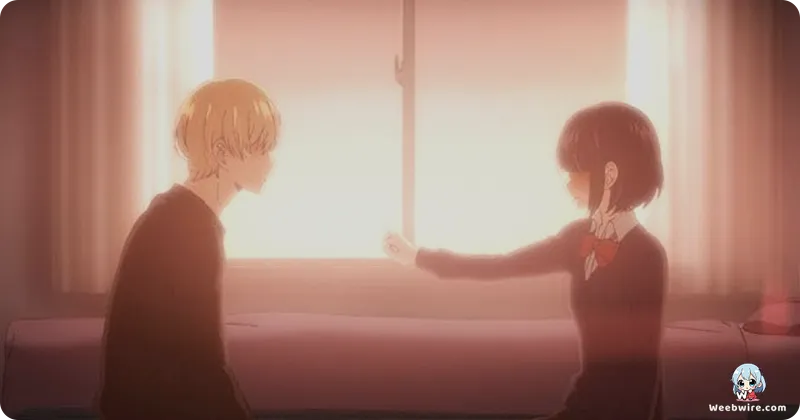Beyond the Surface: Unveiling the Unseen Brilliance and Psychological Artistry of 'Scum's Wish'

Dive deep into the compelling world of Scum's Wish (Kuzu no Honkai), an anime that redefined the romance genre with its unflinching examination of unrequited desire and the intricate web of human relationships. While celebrated for its raw honesty, many fascinating, lesser-known details shaped this critically acclaimed, often controversial narrative. Premiering in January 2017 from Studio Lerche, this adaptation of Mengo Yokoyari's seminal manga boldly ventured where typical love stories dared not tread, exposing the darker, more desperate corners of affection and the painful realities of emotional entanglement.
An Unprecedented Dual Premiere
Perhaps one of the most audacious moves in its production was the deliberate, near-simultaneous premiere of both the anime and a live-action drama adaptation in January 2017. This unprecedented strategy allowed audiences to experience the narrative's intense emotional turmoil and challenging themes across distinct mediums concurrently. Far from being a mere direct transfer, these parallel releases ignited a vibrant dialogue within the fanbase, offering unique perspectives on how each format interpreted Mengo Yokoyari's nuanced psychological landscape. The live-action series, in particular, provided a grounded, visceral counterpoint to the anime's more stylized emotional portrayals, prompting profound discussions about the adaptability and universality of the story's themes. This dual-pronged launch significantly amplified the series' cultural footprint, solidifying its status as a groundbreaking, unconventional portrayal of modern romance that dared to explore the complexities of human connection without idealization.

A Masterclass in Visual Storytelling
Central to Scum's Wish's profound impact is its distinctive artistic vision, a testament to Studio Lerche's meticulous animation prowess and, more significantly, to Mengo Yokoyari's original manga aesthetic. Yokoyari is celebrated for her unparalleled ability to craft expressive character designs, weave intricate symbolism, and articulate profound emotions through the slightest visual cues. The anime masterfully translated these elements, deploying a rich tapestry of abstract visual metaphors, dynamic color shifts, and intensely intimate close-ups—especially on hands and eyes—to vividly portray characters' internal turmoil, raw desperation, and fleeting moments of fragile connection. This sophisticated artistic direction transcends mere dialogue, transforming the animation itself into a potent psychological instrument that mirrors the protagonists' fragmented emotional states. Deliberate stylistic choices, such as stark white backgrounds during moments of agonizing vulnerability or deep, ink-like shadows when despair grips a character, serve to plunge viewers deeper into the fractured psyches on screen, making the emotional pain almost palpable. The use of blurred lines and distorted perspectives further emphasizes the characters' distorted perceptions of love and self, creating a truly immersive and unsettling visual experience.
Mengo Yokoyari's Uncompromising Vision
A pivotal insight into the series' depth lies in Mengo Yokoyari's overarching authorial fingerprint. Devotees of her later, globally acclaimed sensation Oshi no Ko will discover that Scum's Wish served as an early, powerful showcase of her foundational genius for dissecting the entertainment world's hidden underbelly and the darker currents of human desire. Both narratives share an uncompromising commitment to exploring morally ambiguous figures and confronting uncomfortable truths about human nature, interpersonal bonds, and societal pressures. In Scum's Wish, this manifests as a visceral portrayal of unrequited affection, corrosive jealousy, and the self-destructive cycles individuals become trapped in when their emotional voids remain unfilled. Yokoyari famously refuses to sanitize the often-ugly realities of human connection, instead presenting deeply flawed yet undeniably authentic characters. Her narratives consistently challenge audiences to grapple with challenging reflections of reality rather than saccharine, idealized romance, solidifying her consistent authorial voice as a hallmark of her captivating and profoundly unsettling work. This unflinching honesty is what truly sets Scum's Wish apart, forcing viewers to confront the uncomfortable truths about desire and self-worth.
The Power of Sound and Voice
Further cementing the anime's profound resonance are its impeccable sound design and masterful voice acting. Masaru Yokoyama's melancholic original soundtrack serves as an exquisite, understated backdrop, perfectly amplifying the series' somber and desperate atmospheric tension without ever overshadowing the nuanced emotional performances. The music often swells during moments of intense internal conflict, yet it never dictates the emotion, instead subtly enhancing the characters' unspoken feelings. The voice cast, notably Chika Anzai as Hanabi Yasuraoka and Nobunaga Shimazaki as Mugi Awaya, delivered performances of breathtaking raw emotion and vulnerability. Their unparalleled skill in conveying the characters' agonizing internal struggles, their desperate yearning, their profound self-loathing, and their fleeting glimmers of fragile hope through subtle vocal inflections was instrumental in rendering these complex individuals painfully real and relatable, even amidst their morally ambiguous choices. This unwavering dedication to authentic emotional portrayal, synergizing both auditory and visual elements, played a critical role in forging the anime's distinct identity and its enduring impact, leaving a lasting impression on anyone who experiences its narrative depth.
Ultimately, Scum's Wish stands as a deliberate subversion of traditional romance narratives, offering a mature, often heartbreaking odyssey into love, desire, and identity that continues to captivate audiences who prioritize psychological depth over conventional happy endings. Its bold artistic choices, daring narrative structure, and profound character studies firmly establish its legacy as a unique and thought-provoking benchmark in the romance genre, proving that true emotional resonance often lies in the uncomfortable truths.
Credits
Scum's Wish
Author
Mengo Yokoyari
Cover Art
Mengo Yokoyari
Studio
Lerche
Publisher
Square Enix
Producers





